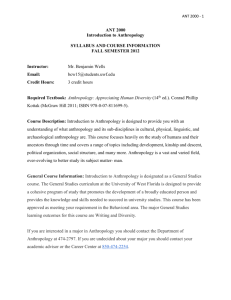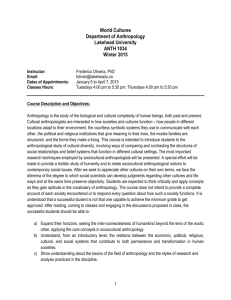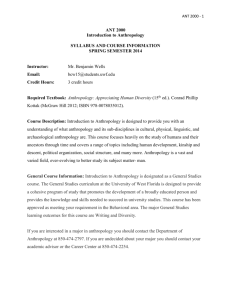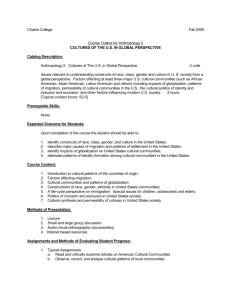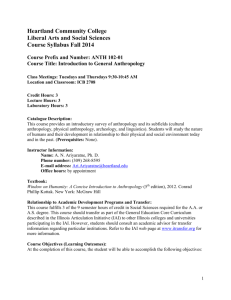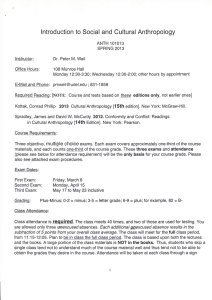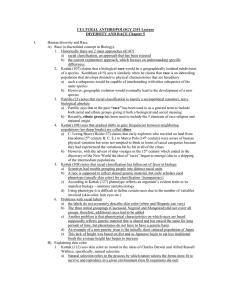Introduction to Anthropology Anthropology 101 Course Description
advertisement
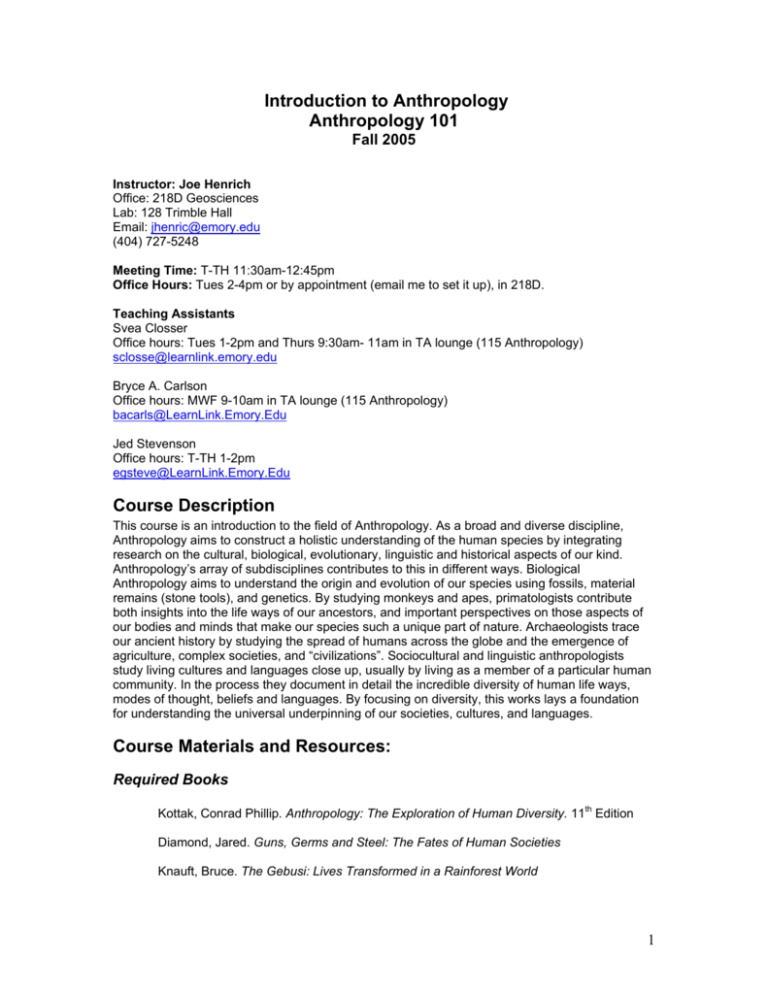
Introduction to Anthropology Anthropology 101 Fall 2005 Instructor: Joe Henrich Office: 218D Geosciences Lab: 128 Trimble Hall Email: jhenric@emory.edu (404) 727-5248 Meeting Time: T-TH 11:30am-12:45pm Office Hours: Tues 2-4pm or by appointment (email me to set it up), in 218D. Teaching Assistants Svea Closser Office hours: Tues 1-2pm and Thurs 9:30am- 11am in TA lounge (115 Anthropology) sclosse@learnlink.emory.edu Bryce A. Carlson Office hours: MWF 9-10am in TA lounge (115 Anthropology) bacarls@LearnLink.Emory.Edu Jed Stevenson Office hours: T-TH 1-2pm egsteve@LearnLink.Emory.Edu Course Description This course is an introduction to the field of Anthropology. As a broad and diverse discipline, Anthropology aims to construct a holistic understanding of the human species by integrating research on the cultural, biological, evolutionary, linguistic and historical aspects of our kind. Anthropology’s array of subdisciplines contributes to this in different ways. Biological Anthropology aims to understand the origin and evolution of our species using fossils, material remains (stone tools), and genetics. By studying monkeys and apes, primatologists contribute both insights into the life ways of our ancestors, and important perspectives on those aspects of our bodies and minds that make our species such a unique part of nature. Archaeologists trace our ancient history by studying the spread of humans across the globe and the emergence of agriculture, complex societies, and “civilizations”. Sociocultural and linguistic anthropologists study living cultures and languages close up, usually by living as a member of a particular human community. In the process they document in detail the incredible diversity of human life ways, modes of thought, beliefs and languages. By focusing on diversity, this works lays a foundation for understanding the universal underpinning of our societies, cultures, and languages. Course Materials and Resources: Required Books Kottak, Conrad Phillip. Anthropology: The Exploration of Human Diversity. 11th Edition Diamond, Jared. Guns, Germs and Steel: The Fates of Human Societies Knauft, Bruce. The Gebusi: Lives Transformed in a Rainforest World 1 Our textbook provides additional material at: www.mhhe.com/kottak11 Blackboard (http://classes.emory.edu) Class lectures will be posted soon after the lecture is complete on Blackboard. You should be able to login. If you cannot, contact the TA Jed Stevenson. Course requirements and weightings for final grade: This course has two mid-course examinations, one final exam, and a “Journal” (explained below). The relative weight in grading breaks down as follows: Grading Instrument Attendance, participation Mid-course Exam 1 Mid-course Exam 2 Journal Final Exam Percentage contribution 5% 15% 20% 30% 30% Attendance Policy: We won’t take attendance regularly. Instead, we’ll “spot-check” by taking attendance whenever I feel like it. This will most likely occur if the class looks underpopulated. Mid-course Exams: These two 70 minute in-class examinations are meant to test your general mastery of the course material. They will be mostly multiple choice and T/F questions, although depending on the size of the class I may (would prefer to) include some short-answer questions. These exams will be non-cumulative, and will cover only material since the beginning of the course, or since the previous exam. Final Exam: The structure of the final and the kinds of questions will mirror the other two exams. However, the final is cumulative over the entire semester and longer. Journals: Each student will maintain a journal with their responses to all homework questions. Journal entries should be in chronological order, carefully labeled with the date, question number, page number (if applicable), and exercise type (at the end of the chapter in Kottak, there are “critical thinking questions” and “internet exercises”; there will also be “instructor assigned questions” and “Knauft Questions” (which are also at the end of the Kottak chapters)). We will periodically (every month or so) collect and grade your journals. However, journals are cumulative (so every time you turn it in, you turn in everything you’ve done). Students are encouraged to work together in figuring out how to answer the homework questions; however final answers (recorded in each student’s own journal) must be in his or her own words. You must bring your journal to class everyday for two reasons: (1) you may want to refer to it during class and (2) we may collect the journals unannounced on any given day. A final version of your journal will be collect on 12/8. If you are absent on the day of a journal collection, you may turn your journal in late with a 20% penalty. Those with excused absences can turn their journals in without penalty. Journals must be in their own notebook. If you prefer to hand write your journal, you may want to use a single subject spiral notebook. If you prefer to use a word processor, pages must be printed and put into some kind of individual notebook for every class (e.g., 3 hole punched notebook). Since you may be asked to hand-in your journal at any time, it should not be included in a notebook with class notes, other course work, letters to friends, etc. Loose sheets, folded sheets or sheets stuck together with gum, staples or paper clips will not be accepted. 2 Appeals regarding exam or journal grades must be made in writing within one week from the day the exams or journals are returned to the class (if you happen to miss that day, the clock is still ticking). All questions regarding journals, as well as notification of excused absences, should be directed to TA Bryce Carlson. All students are reminded that they signed the Emory Honor Code, and are bound by it. Lecture Schedule CTQ = Critical Thinking Questions at the end of Kottak chapters. IE = Internet Exercises at the end of Kottak chapters. Knauft Questions = Questions about Bruce Knauft’s book, The Gebusi, at the end of Kottak chapters. # Date 1 9/1/2005 2 9/6/2005 3 9/8/2005 4 9/13/05 5 9/15/05 Title and Key Topics Introduction. What is Anthropology? The holistic study of humanity. • What are you getting yourself into? • Anthropology vis-à-vis other disciplines. Why we are the best. • What do anthropologists do? • Review of the course and discussion of course policies. Introduction to Genetic Evolution: Processes and Mechanisms • Evolution is a fact, like the earth is egg-shaped. • Natural selection is a theory. • How does evolution work? What is a gene anyway? • How could random mutations possibly create complex things like people, or fish? Reading: Chapters 1 and 4 Journal Assignment: Kottak, Chapter 1: CTQ 2 and 3 (p.22); Chapter 4: CTQ 4 and 5 (p.80). Human Origins: In the beginning there was the common ancestor to humans and chimpanzees…. • Our family tree • Humans are not descended from (extant) monkeys • Multiple species of hominids at same time • How do these guys figure this stuff out? Reading: Chapters 7 and 8 (p. 131-168) Journal Assignent: Chapter 7: Internet Exercise (IE) 1 (p. 146); Chapter 8: CTQ 1 and 4 (p. 167). Meet the Relatives • How similar are apes and monkeys to people? • Chimps do not have tails. • Why study non-human primates? Reading: Chapter 6 (p.101-130) No office hours for Henrich. Doing Paleoanthropology Guest lecturer John Kingston Latest on the Hobbits Assignment: Kottak Chapter 4, CTQ 1 & 2. No Office hours for Henrich. 3 6 9/20/05 7 9/22/05 The emergence of anatomically modern humans • We are all Africans • The “Human Revolution” or the revolution that wasn’t? • Tools, brains and forager life • Why do we care about this, again? Reading Chapter 9 (p. 169-198) Journal Assignment: CTQ 3 and 4 (p.193) and Internet Exercises 1 The Last 10,000 years in Broad Perspective • When did the last ice age end? • When did agriculture first begin? Where? • When was the first city? Where? • It’s good to live in the Holocene. Reading: Diamond Prologue and Part 1 (13-82) Journal Assignment: (1) What is “Yali’s Question”? and (2) What were the key advantages Pizzaro had in defeating Atahuallpa? 8 9/27/05 Film, Discussion and Review 9 9/29/05 Exam I 10/4/05 The Agricultural Revolution and Life in the Holocene • Why did people suddenly start planting stuff? • Was foraging a better life? • Why did this happen in only a few places? Reading: Kottak Chapter 10 (p. 199-223) 10 11 10/6/05 12 10/11/05 13 10/13/05 14 10/18/05 15 10/20/05 The Rise and Spread of Food Production • Where did agriculture first start? • Why did it start there? • Was life better before agriculture? Reading: Diamond Part II (p 83-192) Journal Assignment: CTQ 1,3, 4 (p. 220) Fall Break Culture and Cultural Evolution • What is culture? • How does it transmit? • Does it really affect human brains and psychology? • Is culture really a product of genetic evolution? Reading: Kottak Chapter 11 (p. 223-250) Emerging Societal Complexity • Tribes and Institutions • Chiefdoms, religion and the first cities, States • Division of labor • Why is the history of the rise of complex societies similar in some ways on different continents, yet so different in other ways? • The Tasmania Case Reading: Diamond Part III (p. 193-292) Journal Assignment: Kottak CTQ 5 (p.244) and Why were European germs more lethal to Native Americans than vice versa? Language • Is language a product of evolution? • What linguistic concepts are universal and which are bound to a 4 language? • Can apes learn language? • Can language really affect thought? • How can language help us reconstruct history? Reading: Kottak Chapter 15 Journal Assignment: Kottak IE 2 (p.337) 16 10/25/05 17 10/27/05 18 11/1/05 19 11/3/05 20 11/8/05 21 11/10/05 Making a Living: Economics in broad perspectives • The original affluent society: foraging societies • Why work so hard? • Are markets natural? Reciprocity? Reading: Kottak Chapter 16 (p. 343-368) Journal Assignment: Kottak IE 2 (p. 366). Race and Ethnicity Guest Lecture George Armelagos Reading: Chapters 5 and 14 (p.83-100; p.289-313) No Office hours for Henrich. Film Race: Power of an Illusion Reading: Knauft Part I (p.9-93) Kinship, Marriage and Incest • How many fathers do you have? Barí kids often have 2 or 3. • How ‘normal’ is monogamy? How many husbands do you want? • How much did your wife cost, in cows? • Societies with no marriage? • Do you want to marry any of your first cousins? In many places, that’s the proper thing to do. Reading Chapter 18 and 19 (p 397-440) Journal Assignment: Kottak: Do IE 2 OR 3 (p.415-16) Gender and Sexuality • Sex with cousins? Fun or scandalous? • How natural is homosexuality? Non-humans do it. In some societies, most males have sex with another male before taking a wife. • Why are boys and girls different? Do males have different brains than females? • What are the societies like in which females dominate the politics and leadership? We don’t know … yet. Reading: Kottak Chapter 20 Fieldwork Among the Gebusi Guest Lecturer: Bruce Knauft Reading: Knauft Part II (p.93-158) Journal Assignment: Knauft Questions on p.439 and p. 463 (Kottak). 22 11/15/05 Film, Discussion and Review: First Contact (54 minutes) Journal Assignment: Knauft Questions on p. 416 (Kottak). 23 11/17/05 Exam II 11/22/05 Religion, Myth and Magic • Do all societies have religions? What about rituals? • Witchcraft and ghosts are extremely widespread and remarkably similar in different places. What does this suggest? • Why isn’t prayer considered a type of magic? 24 5 • Why don’t we call the Bible a book of myths? Reading: Chapter 21 (p. 469-492) Journal Assignment: Kottak IE 1 (p. 491) 25 11/24/05 26 11/29/05 27 12/1/05 28 12/6/05 29 Thanksgiving, no class. Medical and Applied Anthropology • What killed about 2 million people in 2004, seven times as many as the tsunami? (Hint: it’s curable.) • Why is an anthropologist responsible for the expansion of effective treatment for this disease across the world? • Can you really kill someone using voodoo? • The importance of anthropology in the “real world” Guest Lecturer: Svea Closser Reading Kottak Chapter 2 (p. 25-41) Colonialism, Globalism and Development Reading Chapters 23 and 24 Journal Assignment: Kottak IE 2 and Knauft Questions (p. 555) Expansions in Human History Was the expansion of Europeans starting in 1492 a unique event in human history, or is history characterized by the expansion of one people at the expense of others? Reading: Diamond Chapters 17, 18, 19 (p. 334-402) 12/8/05 Film and Discussion Journal Assignment: Journals DUE 30 12/13/05 Review for Final Exam 31 12/16/05 Final Exam 4:30pm to 7pm 6
